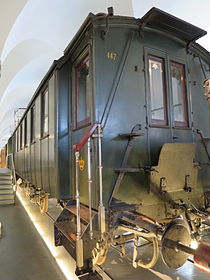Salon 3, see 85
| Court saloon car No. 447 | |
|---|---|
|
overall view
|
|
| Numbering: | 447 |
| Number: | 1 |
| Manufacturer: | Hofmann Brothers AG Wroclaw |
| Year of construction (s): | 1885 |
| Retirement: | 1954 |
| Genre : | Salon 3 |
| Gauge : | 1435 mm ( standard gauge ) |
| Length over buffers: | 11,670 mm |
| Height: | 4015 mm |
| Width: | 2900 mm |
| Total wheelbase: | 8000 mm |
| Service mass: | 19.3 t |
| Train brake: | Handbrake |
| Train heating: | Steam heating line and briquette oven |
| Seats: | 12 3 beds |
The salon car Salon 3 (-sa 85) with the car number 447 is the last surviving copy from the Saxon court train .
history
The King of Saxony had owned two saloon cars since 1853. The fleet for the court train was expanded and replaced several times in the Kingdom of Saxony until 1912. The court salon car 447 was built in 1885 by Gebrüder Hofmann AG (later: Linke-Hofmann-Busch) in Breslau for the daughter of the later King of Saxony, Georg , Mathilde von Sachsen .
After the end of the monarchies in Germany in 1918, the car was used for minor purposes. 1954–1956 it was refurbished in its original state in the Reichsbahn repair shop in Karl-Marx-Stadt . Today it is in the permanent exhibition of the Dresden Transport Museum .
Technical
The room layout is typical for a saloon car of this time: At one end there is a closed entry, then the salon, in the middle a sleeping compartment with attached toilet and washing facilities for the princess. A side corridor led to the compartment for the accompanying staff. This area also had entrance doors.
The drawing room was furnished with a sofa, a table and four armchairs. There were three seats in the personnel compartment.
The chassis of the car is made entirely of steel profiles . The long and cross members were riveted together. The structure was made of wood, clad with sheet metal. There was only a passage at the entrance to the salon rooms. The roof was provided with a skylight structure.
The heating could either be operated with briquettes and was then fired from the outside. Alternatively, there was a heating cable if the car was used in steam-heated trains . The vehicle had gas lighting . The car ran on three fixed axles and was equipped with a handbrake.
The car also had continuous screw couplings and rod buffers.
literature
- Labeling on the object in the Dresden Transport Museum.
- Magistrate of the City of Potsdam (Ed.): Catalog. European saloon car exhibition from 22. – 23. May 1993 on the premises of Raw Potsdam . Potsdam 1993, p. 64 f., No. 33.
- Wolfgang Theurich, Joachim Deppmeyer: Passenger coaches 3. Dining, sleeping and salon coaches . transpress, Berlin 1994, ISBN 3-344-70904-6 , pp. 230 f., 3491 .


